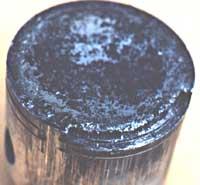
quality. service. price.
Head Gasket Failure

Head Gasket Failure
Head gasket failure can be extremely destructive to your engine and should not be ignored. In air cooled engines, a blown head gasket will allow very hot exhaust gasses to escape by the gasket on the compression stroke. This will act like a cutting torch and ruin your head, cylinder, or both. In some cases, this can be repaired by building the surface up with weld and then milling flat. Tell tale signs of head gasket failure in air cooled engines are:
- Oil leaks between the cylinder and head.
- The sound of air escaping at the leak when you try to start the engine.
- Low or little compression
Complications from head gasket failure in water cooled engines are far more destructive. Here's why. When a gasket fails on a liquid cooled engine, your going to lose coolant. When you lose coolant, your engine will overheat and eventually blow. If the coolant is making its way into the cylinder, it will wash down the cylinder walls and cause a loss of lubrication. This will, in many cases, destroy your piston and cylinder. The coolant will contact the top of the piston causing it to cool rapidly. The piston top will appear very clean and pitted, usually by the exhaust port. Fortunately this is seldom the case. In the battle of water pressure VS compression, compression most always wins. Compression makes its way into your radiator and forces the coolant out of the overflow tube.
If your engine has O-ring head gaskets, make sure they are seated in the grooves. Stretch them out a little if you have to. Also check that the cylinder head nuts are in good shape and are the flange ,cap type. All O-ring head gaskets need these type of nuts or the coolant will leak between the stud and nut. If you have a stamped steel head gasket, like Kawasaki KX type, coat it with a thin coat of aluminum spray paint before you install it. This will help to seal. Some gaskets come from the factory with a coating on them. If this is the case, don't use the paint. Check the head and make sure it's flat. You can do this with a piece of glass and a feeler gauge . If you find the head to be at fault, we can repair it . If you started having problems with head gaskets right after you had a sleeve installed, make sure the sleeve is level with the top of the cylinder and didn't drop. This is a common mistake that a lot of companies make.

Piston damaged from an internal coolant leak
Here are a few tips to help with your gasket installation:
- Make sure the top of the cylinder and the head are flat and clean.
- Never use any type of sealer or bonding agent on head gaskets. Spray a THIN coat of aluminum spray paint on uncoated steel or copper head gaskets only.
- Never re-use old gaskets. Trust me on this . It wont work.
- Don't over-tighten your head bolts. This will MAKE your gasket leak. Use recommended torque specs.
- Some gaskets are directional. Steel gaskets have the ribs facing up. Most of the time they are marked as such. Smaller holes for the coolant to pass through are most always on the exhaust side of the cylinder.
- Composite gaskets need to be re-torqued after the first warm up. Let the bike cool down completely before you re-torque. Steel and O-ring head gaskets don't need to be re-torqued.
© 1983-Present by Ken OConnor Racing. All rights reserved.


